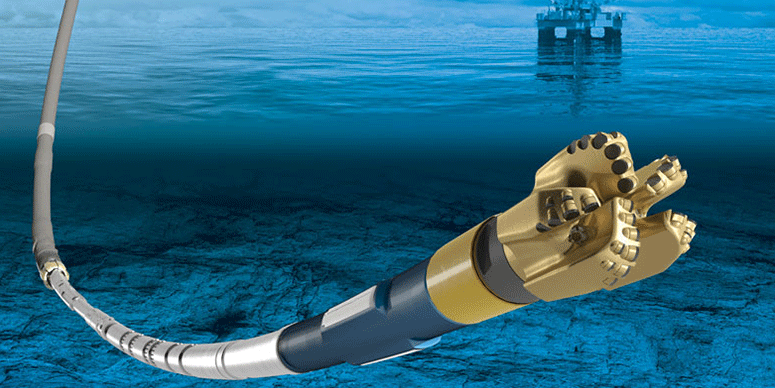While rotary-steerable systems (RSSs) dominate the offshore directional-drilling markets, the landbased markets are still dominated by conventional directional-drilling tools. This paper presents a new RSS that is being designed and tested specifically for the onshore markets. The new tool is a short RSS that is designed to deliver a buildup rate of 15°/100 ft. It achieves this by the movement of two eccentric shafts relative to one another within the tool.
Introduction
For directional drilling to be successful, it is important that the drillers have information on the orientation of the tool while they are drilling so they can best align the wellbore orientation to the reservoir target. Commonly, this is achieved with a measurement-while-drilling (MWD) tool that is typically 50.ft or more behind the drill bit. In some cases, these measurements are supplemented with some form of near-bit inclination reading. A further improvement would be to have both inclination and azimuth measured close to the bit and integrated into the drilling tool’s directional response, thereby enabling precise well placement without the need to project and correct continually from the MWD tool that lags considerably behind the drilling tool. This is the method adopted by the RSS described in this paper.
In many cases, a downhole positive displacement motor will be used with the RSS to increase rate of penetration (ROP) and reduce casing wear by minimizing string rotation. The RSS described in this paper was designed to be driven directly by the top drive or with a mud motor.
Three prototypes of the new RSS have been designed and tested so far. The first prototype (Prototype A) successfully demonstrated dogleg-severity capability of 15°/100 ft. The second prototype (Prototype B) was designed to evaluate the efficiency of the selected motor-gear design in moving the eccentric shafts when applying significant side loads. The third prototype (Prototype C) was a complete rotary-steerable tool that verified all aspects of the design, culminating in the drilling of directional holes in concrete blocks. This paper describes the development of Prototype C, covering design, manufacture, and the drill tests that verified the 15°/100 ft dogleg performance through concrete-block drilling. The paper also covers the subsequent design improvements made before manufacture of the field-test prototypes (Prototype D) and the planned environmental and endurance testing of Prototype D before field testing.
Background Theory
The RSS described in this paper is based on the push-the-bit method for adjusting the direction of the well path. The position of the drill bit is controlled continuously by the direction and offset of a near-bit stabilizer that is supported on two eccentrically drilled sleeves. The amount of eccentricity is exactly the same for both sleeves so that, when they are positioned opposite each other, the net offset is zero and, therefore, the drill bit will have no side force and will drill straight ahead. As soon as the two sleeves are rotated relative to each other, the bit will be offset. The tool face and amount of offset can be varied continuously, giving smooth control of the drill string orientation and buildup rate.
However, because this RSS controls bit position by displacement of a rigid, nonrotating stabilizer to alter the bottomhole-assembly geometry rather than moving external parts to apply a side force to the borehole wall, the steering action described in this paper is expected to be less affected by changes in formation strength. The three-point geometry model that is used to determine the bent motor buildup rate is as applicable to this RSS as is the resultant force vector based on weight on bit (WOB) and side force, leading to an RSS that is less sensitive to the ratio of WOB to formation strength. The side force being applied is also not reliant on mud flow, so the tool will operate in soft formations that are liable to wash out. Another important benefit of this relatively rigid steering stabilizer is that fewer moving parts are exposed to the borehole annulus; very little movement of these parts is required to effect a significant side force.
Development Process
Prototype A was made for an 8 1/2-in. drill bit. After Prototype A had been tested, a functional specification for the system was developed. The specification was fine-tuned during the testing of Prototype B and the development of Prototype C. The lessons learned during the testing of Prototype C and the subsequent design review informed the updating of the functional specification for Prototype D, the field-test-pilot series.
Prototype A. Prototype A was designed and manufactured with short lead-time motor and gear components. The prototype was built to prove the steering concept and to measure steering forces.
Prototype B. Prototype B comprised a new steering head that could deliver the forces required to create a steering response and survive the loads in a downhole drilling environment. This model comprised a custom-designed hollow motor and gear solution .
Prototype C. The significant change for Prototype C was that it was designed to suit the drilling of 7 -in. hole. The design was improved further by splitting the motors/gears and stabilizer steering section into two separate modules. This made it possible to isolate almost all of the steering stabilizer’s drilling loads into a separate section of the tool. Prototype C was a complete system built to demonstrate that the steering concept functioned in a predictable and controllable manner while drilling.
Prototype D. Prototype D is the field test- pilot series based on Prototype C, redesigned to meet requirements for a production series run, including a modular design to make assembly and servicing simpler. It also benefits from increased motor-gear efficiency through improved bearing design and reduction of other losses, as well as an increased temperature and pressure rating to meet real-world environmental requirements. The overall geometry and key design elements from Prototype C were maintained.
Testing
Simulating real-world drilling conditions during testing of the RSS was always seen as challenging. The main objective was to ensure that the tool released for field testing would be tested sufficiently to avoid premature failures.
Some testing equipment was obvious, such as ovens and vibration tables for testing of electronics boards. Less clear, initially, were the motor- and gear test setups, the horizontal-drilling machine, the endurance-test bench, and the component-shock machine that were identified as the RSS developed and existing testing mechanisms proved to be insufficient.
A bench-test setup was used for verifying the efficiencies of motors and motor/ gearbox combinations, with power and torque in and out being measured continuously. This test setup was critical in evaluating improvements in the bearings being used and in the configuration of the gearbox.
A horizontal-drilling machine was used for controllably applying WOB and monitoring ROP. Coupled with a standard 900-hp mud pump and a conventional mud motor, the system has a stroke of 10 ft, with two pneumatic cylinders providing up to 7 t of WOB and the option to add drill collars as required to drill additional length.
A horizontal-test rig was used that can rotate the assembly at up to 200 rev/min, provide fluid circulation (up to 400 gal/ min to generate power and cool bearings), and apply WOB and lateral bending load to generate up to 50 G of axial shock twice per revolution and apply a side load along with drag force to the nonrotating stabilizer. This rig was designed after the initial drill tests through concrete proved to be too smooth, with very little shock and vibration. The goal was to provide extended periods of controlled shock and drilling loads to the whole system while it was operating.
A single-axis shock machine was used that was capable of generating up to 200. G of shock approximately once per second to assemblies weighing up to 50. kg. The magnitude and duration of shock can be adjusted by modifying the material used for contact when the assembly is dropped and the height of the cam used for operating the arm. The shock generated is measured by an accelerometer mounted on the test assembly.
Conclusions
The new RSS development could substantially change the drilling landscape within the unconventional plays in the US land market. The tool is short and highly maneuverable and can be adjusted continuously. It also has directional sensors close to the bit (6 ft behind) that enable close control and adjustment of the well path. The geometry and design of the tool enable short-radius wells to be drilled (dogleg severities of up to 15°/100. ft), which is in line with the best available in the industry today.
The testing and development process has been a staged progression, from a simplistic full-scale proof of concept to a fully functioning RSS prototype that has undergone significant drill and endurance testing.
The four prototypes have become more sophisticated over time, with an associated testing regime commensurate with their capability. Having a smart and highly maneuverable drilling tool is not enough to generate success in the onshore drilling market. Testing needs to ensure that it is also highly reliable and can endure.


 石油圈
石油圈
